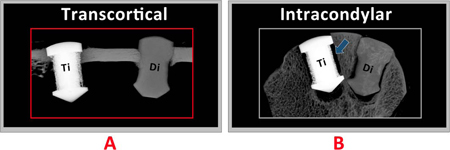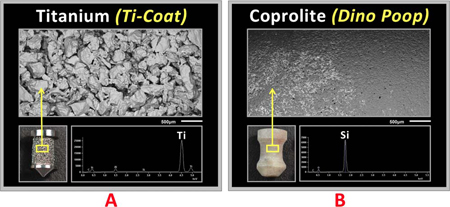 Roy Bloebaum used fossilized dinosaur poop to repair sheep bones. The repair of bones can be an intricate undertaking. Dr. Bloebaum (and colleagues!) hoped to demonstrate how easy it can be to make iffy assumptions. They chose dinosaur feces fossil material to attract attention that could then be focused on certain intellectual aspects of bone repair. They describe this, in technical language, in a newly published study:
Roy Bloebaum used fossilized dinosaur poop to repair sheep bones. The repair of bones can be an intricate undertaking. Dr. Bloebaum (and colleagues!) hoped to demonstrate how easy it can be to make iffy assumptions. They chose dinosaur feces fossil material to attract attention that could then be focused on certain intellectual aspects of bone repair. They describe this, in technical language, in a newly published study:
“Transcortical or intracondylar? Which model is accurate for predicting biomaterial attachment in total joint replacement?” Roy D. Bloebaum [pictured here], Nicole T. Abdo, Aaron A. Hofmann, Richard T. Epperson, Raymond E. Olsen, and Ornusa Chalayon, Journal of Biomedical Materials Research Part B, epub 2017. They authors, at the Bone & Joint Research Laboratory, DVA SLC HCS, Salt Lake City, Utah, and the University of Utah, report:
Despite four decades of research on material and porous coatings intended for cementless fixation in total joint replacement (TJR), aseptic mechanical loosening unrelated to particulate disease remains a concern….
Porous-coated commercially pure titanium implants (Ti-Coat) were from Thortex Inc., Portland Oregon and were used as the material to test the hypothesis (control). Commercially pure titanium has been shown to provide successful attachment clinically in TJR. Coprolite implants, from David Gillette with Utah State University, commonly known as petrified dinosaur poop (Dino), were used to establish a dramatic understanding that even this unique material (which would never be used in TJR) might demonstrate that bone could hypothetically bridge a 500 mm gap at the transcortical location, but possibly not at the weight-bearing intracondylar location….
In conclusion, the results of this investigation emphasize that biomaterial scientists, manufacturers, investigators, and orthopedic surgeons should be aware of the inferior healing properties of cancellous [the inner, spongily-structured, portion of] bone as compared to cortical [the outer, more-compactly-structured portion of] bone and how these results suggest a false-positive nature of the transcortical model in TJR. The results showed that even petrified dinosaur feces could be mechanically stable in the transcortical model.
Here are further details from the study:


(Thank to Donald W. Howie for bringing this to our attention.)
